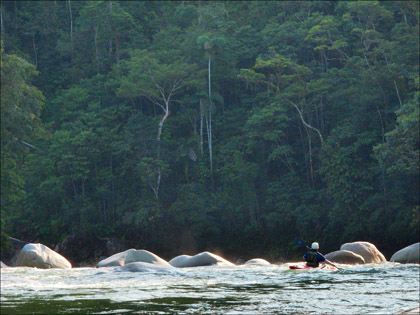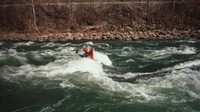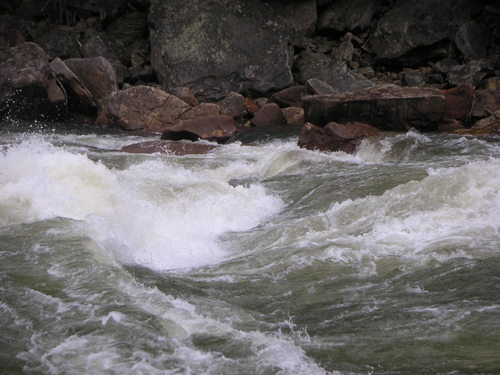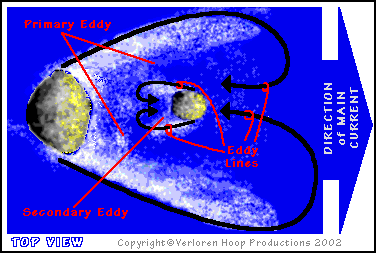Introduction
To really progress in running whitewater, you need to develop solid rapid reading skills. Proper reading of rapids enables the paddler to safely and efficiently navigate their way downstream. Most beginner paddlers look a short distance in front of their boats. They worry about the minor features and often lose sight of major obstacles further downstream until it is too late. As they gain more experience and comfort in their boat, their field of vision increases. Many novice and intermediate paddlers are in a hurry to "step it up". They often follow other paddlers down rapids instead of reading and taking their own lines. This is a really bad habit to get into. If the person in front of you has to stop suddenly or flips, you no longer have someone to follow. Try to chart your own course or at least figure out why certain lines are better than others.
The Downstream V
 Rapids are formed by water running over and around rocks and ledges. The most basic feature is the downstream V that develops when water runs between two rocks. This feature is also known as a tongue. Generally, this is what you want to aim for.
Rapids are formed by water running over and around rocks and ledges. The most basic feature is the downstream V that develops when water runs between two rocks. This feature is also known as a tongue. Generally, this is what you want to aim for.
The Upstream V
The opposite of this feature is an upstream V. In an upstream V, water rushes around a rock. In the previous picture, you can clearly see two upstream V's. In general, we try to avoid upstream V's or at least lean into the rock to avoid capsizing.
The Horizon Line
 A horizon line often denotes the beginning of a steep drop or ledge. If the rapid is known to be safe, I like to cautiously paddle to the middle of the river to get a better look. You can use your back ferry or draw strokes to move laterally to line up for the best position to start the drop. If you can find an eddy close to the ledge, go catch it and get a better look from your boat.
A horizon line often denotes the beginning of a steep drop or ledge. If the rapid is known to be safe, I like to cautiously paddle to the middle of the river to get a better look. You can use your back ferry or draw strokes to move laterally to line up for the best position to start the drop. If you can find an eddy close to the ledge, go catch it and get a better look from your boat.
Waves
 Waves come in many shapes and sizes.
Waves come in many shapes and sizes.
As a general rule, they are very safe and a lot of fun. A wave train is simple a series of waves. A good approach is to hit the waves head on and simply paddle over top of them. You can easily scout at the crest of each wave and turning at wave tops is real easy as well.
Holes
 Holes, reversals, souse holes, and stoppers are synonyms. They are formed when water drops over a ledge or boulder and the water downstream of the obstacle rushes back up stream to fill in the void. When you first start paddling, you want to avoid these features. As you gain more skills and become an advanced paddler, you will often use holes as eddy alternatives, for play time, or for quickly crossing a river. Holes come in all shapes and sizes and are sometimes quite challenging to read. River wide holes that are perfectly uniform are typically created by a manmade structure like a dam - these should almost always be avoided as they can be death traps. Here is a video of Swimmers Hole on the Lower Yough: Lower Yough Swimmers Hole.
Holes, reversals, souse holes, and stoppers are synonyms. They are formed when water drops over a ledge or boulder and the water downstream of the obstacle rushes back up stream to fill in the void. When you first start paddling, you want to avoid these features. As you gain more skills and become an advanced paddler, you will often use holes as eddy alternatives, for play time, or for quickly crossing a river. Holes come in all shapes and sizes and are sometimes quite challenging to read. River wide holes that are perfectly uniform are typically created by a manmade structure like a dam - these should almost always be avoided as they can be death traps. Here is a video of Swimmers Hole on the Lower Yough: Lower Yough Swimmers Hole.
Eddies
 Eddies are your friend! All good boaters catch eddies and use them to control their descent downstream. A good rule of thumb in paddling is to never leave an eddy until the coast is clear from above and you can see how to reach an eddy below. Here is an excellent diagram of an eddy.
Eddies are your friend! All good boaters catch eddies and use them to control their descent downstream. A good rule of thumb in paddling is to never leave an eddy until the coast is clear from above and you can see how to reach an eddy below. Here is an excellent diagram of an eddy.
Pillows
 Another river feature you will certainly encounter is a pillow. This feature is caused by water piling up on a boulder. As will all rocks, you generally lean towards them to lift the upstream edge of your boat out of the water. Here is an excellent example from the Gauley called Pillow Rock.
Another river feature you will certainly encounter is a pillow. This feature is caused by water piling up on a boulder. As will all rocks, you generally lean towards them to lift the upstream edge of your boat out of the water. Here is an excellent example from the Gauley called Pillow Rock.
River Bends
When current flows around a bend in a river, it flows much faster and deeper on the outside of the bend. The velocity and depth on the inside of a river bend is much slower and shallower. You can use this to your advantage by sneaking on the inside and eventually moving more towards the center when you feel comfortable.
Further Resources
The following vuideo from Eric Jackson does a great job in explaining River Hydrology: River Reading. This is another fun video: Reading Whitewater.
A shorter article on river reading with great diagrams is: River Reading Article.
I also highly recommend William Nealy's KAYAK book. This book does an excellent job of describing river reading in depth and is absolutely hilarious. Here it is on Amazon.com: William Neely's Kayak Book.
